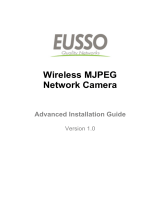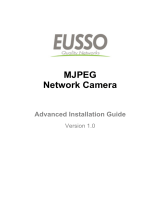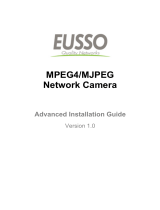Page is loading ...

SkyIPCam1747W
Wireless N Night Vision Pan/Tilt
Network Camera
Model # AICN1747W
User’s Manual
Ver. 1.0

-
1
-
CHAPTER 1 ................................................................................................................. 2
INTRODUCTION TO YOUR CAMERA ................................................................... 2
1.1 Checking the Package Contents............................................................................................... 2
1.2 Getting to Know Your Camera ..................................................................................................3
1.3 Features and Benefits ...............................................................................................................5
1.4 System Requirement................................................................................................................. 6
CHAPTER 2 ................................................................................................................. 7
HARDWARE INSTALL ATION ................................................................................. 7
2.1 Installing the Wall Mount Kit ......................................................................................................7
2.2 Connecting the Camera to LAN/WLAN..................................................................................... 8
2.3 Applications of the Camera ....................................................................................................... 9
CHAPTER 3 ............................................................................................................... 10
SOFTWARE INSTALLATION ................................................................................ 10
3.1 Installing SkyIPCam Utility ......................................................................................................10
3.2 Using SkyIPCam Utility............................................................................................................12
3.3 Viewing Images........................................................................................................................16
CHAPTER 4 ............................................................................................................... 16
CONFIGURATION .................................................................................................... 19
4.1 Using the Web Configuration ..................................................................................................19
4.2 Basic Setup..............................................................................................................................19
4.3 Network Settings .....................................................................................................................22
4.4 Pan/Tilt Settings ......................................................................................................................28
4.5 Setting up Video & Audio ........................................................................................................29
4.6 Event Server Configuration .....................................................................................................32
4.7 Motion Detect...........................................................................................................................34
4.8 Event Configuration .................................................................................................................35
4.9 Tools ........................................................................................................................................39
4.10 Information...............................................................................................................................40
CHAPTER 5 ............................................................................................................... 41
USING SKYIPCAM ULTRAVIEW.......................................................................... 41
5.1 Starting the Program ...............................................................................................................41
5.2 Main Window and Item Feature ..............................................................................................42
5.3 Accessing the Camera ............................................................................................................45
5.4 Recording / Playing Video .......................................................................................................50
5.5 Configuring the eMap View Setting.........................................................................................54
5.6 Configuring the System ...........................................................................................................59
5.7 Event Configuration .................................................................................................................60
5.8 Changing System Language...................................................................................................63
5.9 Terminating Operation.............................................................................................................64
APPENDIX ................................................................................................................. 65
A.1 Specification ............................................................................................................................65
A.2 GPIO Terminal Application......................................................................................................67
A.3 Glossary of Terms ...................................................................................................................68
TECHNICAL SUPPORT ............................................................................................... 73

-
2
-
C
HAPTER
1
I
NTRODUCTION
T
O
Y
OUR
C
AMERA
1.1 Checking the Package Contents
Check the items contained in the package carefully. You should have the following:
One Wireless N Night Vision Pan/Tilt Network Camera
One 2dBi Antenna
One AC Power Adapter
One Wall Mount Kit
One GPIO Connector
One Ethernet Cable (RJ-45 type)
One Installation CD
One Quick Installation Guide

-
3
-
1.2 Getting to Know Your Camera
Front View

-
4
-

-
5
-
1.3 Features and Benefits
MJPEG Codec Supported
The camera provides you with excellent images by the MJPEG codec technology, allowing you to
adjust image size and quality, and bit rate according to the networking environment.
2-way Audio Capability
The built-in microphone of the camera provides on-the-spot audio via the Internet, allowing you to monitor
the on-site voice. In addition, you can connect an external speaker to the camera to talk to people at the
camera view.
Day & Night Surveillance Supported
The seven Infrared LEDs around the standard lens assembly enable the camera to capture crystal clear
images in dark environments or at night. When the Light Sensor detects the environmental light level as
being too low, the camera captures the images in black & white mode using these infrared LEDs.
Optimal Viewing
With the pan/tile functions, you can easily monitor everywhere via the camera by moving the camera lens
to the left/right (165/165 degrees) or up/down (90/15 degrees). In addition, you can assign up to eight
positions for the camera, enabling you to move the camera lens to the desired position quickly.
I/O Connectors Provided
The camera provides the I/O connectors on the rear panel (IN/OUT), which provide the physical interface
to send and receive digital signals to a variety of external alarm devices. You can connect a special
featured device, and then configure the settings and control the device from the GPIO Trigger window of
Web Configuration.
Remote Control Supported
By using a standard Web browser or the complimentary software SkyIPCam UltraView application, the
administrator can easily change the configuration of the camera via Intranet or Internet. In addition, the
camera can be upgraded remotely when a new firmware is available. The users are also allowed to
monitor the image and take snapshots via the network.
Multiple Platforms Supported
The camera supports multiple network protocols, including TCP/IP, SMTP e-mail, HTTP, and other Internet
related protocols. Therefore, you can use the camera in a mixed operating system environment, such as
Windows 7 and Windows XP.
Multiple Applications Supported
Through the remote access technology, you can use the cameras to monitor various objects and places for
your own purposes. For example, babies at home, patients in the hospital, offices and banks, and more.
The camera can capture both still images and video clips, so that you can keep the archives and restore
them at any time.

-
6
-
1.4 System Requirement
Networking
- LAN: 10Base-T Ethernet or 100Base-TX Fast Ethernet.
- WLAN: IEEE 802.11b/g/n, data rate up to 150Mbps*
Accessing the Camera using Web Browser
- Supported Browsers*: Microsoft® Internet Explorer 6.0 or above; Apple Safari, Mozilla Firefox
with JAVA plug-in
CPU: Intel Pentium III 800MHz or above
RAM: 512MB
Resolution: 800x600 or above
Accessing the Camera using Software SkyIPCam UltraView
Platform: Microsoft® Windows® 7, Vista and XP
Hard Disk: 80GB or above
Resolution: 1024x768 or above
Suggested Hardware Requirement*
▪ 1~8 cameras connected: Intel Core 2 Duo; 2GB RAM
▪ 9~32 cameras connected: Intel Core 2 Quad; 4GB RAM
NOTE If you connect multiple cameras to monitor various places simultaneously, it is recommended that
you use a higher end computer. Viewing multiple cameras on a lower end computer can cause
performance issues.
* It is recommended to use Internet Explore to view/manage the camera, because Safari and Mozilla
Firefox may not support certain features, such as configuring motion detection or digital zoom, snapshot.

-
7
-
C
HAPTER
2
H
ARDWARE
I
NSTALLATION
2.1 Installing the Wall Mount Kit
The camera comes with a Wall Mount Kit, which allows you to place your camera anywhere by mounting
the camera through the three screw holes located in the base of the Wall Mount Kit.
Wall Mount Kit
Screw
Screw
Screw

-
8
-
2.2 Connecting the Camera to LAN/WLAN
Use the provided Ethernet cable to
connect the camera to your local
area network (LAN).
When you connect the AC power
adapter, the camera is powered on
automatically. You can verify the
power status from the Power LED
on the front panel of the camera.
Once connected, the Link LED
starts flashing green light and the
camera is on standby and ready
for use now.
If you use a wireless network in
your application environment, you
need to attach the included
external antenna to the camera.
When the camera is powered on,
the camera will automatically
search any access point with
“airlink101” SSID.
Connecting the Ethernet Cable
Connecting the External Antenna

-
9
-
2.3 Applications of the Camera
The camera can be applied in multiple applications, including:
Monitor local and remote places and objects via Internet or Intranet.
Capture still images and video clips remotely.
Upload images or send email messages with the still images attached.
The following diagram explains some of the typical applications for your camera and provides a basic
example for installing the camera.

-
10
-
C
HAPTER
3
S
OFTWARE
I
NSTALLATION
3.1 Installing SkyIPCam UltraView
Step 1 Insert the provided CD into your computer’s CD ROM drive.
Step 2 Click on Install Utility and Software.
Note: If you do not see the autorun menu pops up on the screen, please go to your CD-ROM drive >
UltraView folder > run “Setup.exe”.
Windows 7 and Vista users: Please make sure your give permission to run the setup program.

-
11
-
Step 3 Click Install to install the utility.
Step 4 Click Finish when installation finishes.

-
12
-
3.2 Configuring the Camera
Step 1 Open SkyIPCam Utility by double clicking on its icon on your desktop.
Step 2 Click on Search to find the camera on your network. Select the Camera you wish to configure and
click on Link.
Note If the Camera you wish to configure does not show up in the utility, make sure the camera is
properly connected to the same local network as your computer is, and the Green LED should be on.
Click on Search to try again.
Step 3 When you are prompted for the username and password, enter “admin” for both Username and
Password, and click OK.

-
13
-
Step 4 The camera viewing window will appear. Click on Setup, then click on Smart Wizard.
Step 5 You may change the default Camera Name and enter a name for the Location if you like. Then
enter “admin” for both Admin Password and Confirm Password. Click Next.
1
2

-
14
-
Step 6 You can specify a static IP address to this camera by selecting Static IP, and enter IP, Subnet
Mask, Default Gateway, Primary/Secondary DNS addresses here.
If you are not sure how to configure Static IP Setting, please select DHCP. Click Next.
Note Be sure to enter Primary/Secondary DNS addresses assigned by your ISP if you set up Static
IP for the camera so that the Email alert / FTP uploading can function properly.
Step 7 If you would like to set up email alerts that you can receive in the future, enter your email
information here. You can get this information from your Email Service Provider. You can set this up at a
later time. Click Next.

-
15
-
Step 8 Enter the Network ID (SSID) of your wireless network, or click on Site Survey and select from the
list. Select the Authentication and Encryption, and enter the security Key of your wireless network. This
information is stored in your wireless AP/router. Click Next.
Note You may contact the manufacturer of your wireless router/AP’s to find out its SSID and wireless
security settings.
Step 9 Confirm your settings at this page. If everything is correct, click Apply to save the settings, then
the camera will restart in 50 seconds.
Step 10 After the camera is restarted, unplug the network cable from it. It will take around 1 or 2 minutes
for the camera connecting to your wireless router/AP.
To make sure the wireless connection is successfully established, open the SkyIPCam Utility and click
on Search. If the camera shows up in the list, it is connected to your wireless network successfully. If not,
please verify the SSID and the wireless security settings you configured at Step 8 are correct.

-
16
-
3.3 Viewing Images
Method A > Access Camera from SkyIPCam Utility
Step 1A Open Airlink101 SkyIPCam Utility, select the camera you wish to connect to and click on Link
button. Go to Step 3.
Method B > Access Camera from Web Browser
Step 1B If you assigned a static IP address for your camera (at Step 6, Chapter 3.2), you may open the
Web Browser on your computer.
Step 2B Type the IP address of your camera in the Address bar, and press Enter.
Step 3 Enter administrator’s username and password of the camera, then click OK. The default
username and password are both “admin” if you did not make any change to it at Step 5, Chapter 3.2.

-
17
-
Step 4 Internet Explorer User: If this is the first time for your computer to view image from the web
configuration page, you will be prompted to install the ActiveX Control. Click on the bar on top of the
screen and click on Run Add-on or Install ActiveX Control (depends on different IE versions).
Step 5 Click on Run, then you will be able to view the image.
Note If you are using Mozilla Firefox or Safari and you are not able to view any image, please make sure
you have Java and Quick Time add-ons installed.

-
18
-
Step 6 To get a clear view of images, you can simply rotate the camera’s lens clockwise or counter-
clockwise to adjust the focus.

-
19
-
C
HAPTER
4
C
ONFIGURATION
4.1 Using the Web Configuration
You can access and manage the camera through the Web browser and the provided software application
SkyIPCam UltraView. This chapter describes the Web Configuration, and guides you through the
configuration of the camera by using the web browser.
To configure the camera, click Setup on the main page of Web Configuration. The Web Configuration will
start from the Basic page.
4.2 Basic Setup
Basic >> System
The Basic menu contains three sub-menus that provide the system settings for the camera, such as the
Camera Name, Location, Date & Time, and User management.
Basic
- Camera Name: Enter a descriptive name for the camera.
- Location: Enter a descriptive name for the location used by the camera.
Indication LED
This item allows you to set the LED illumination as desired. There are two options: Normal and OFF.
/



